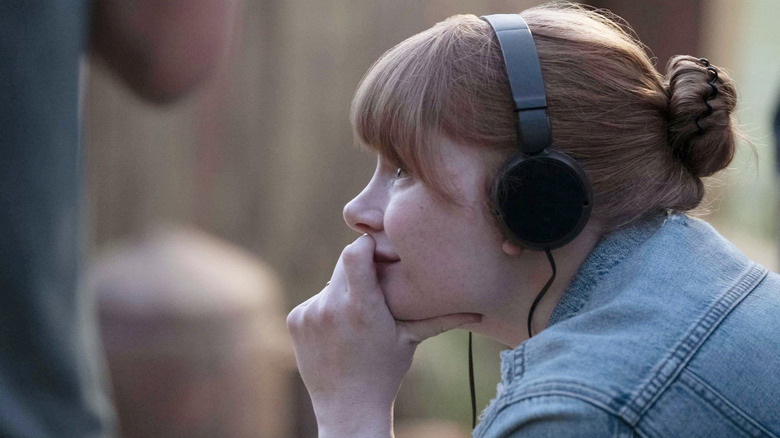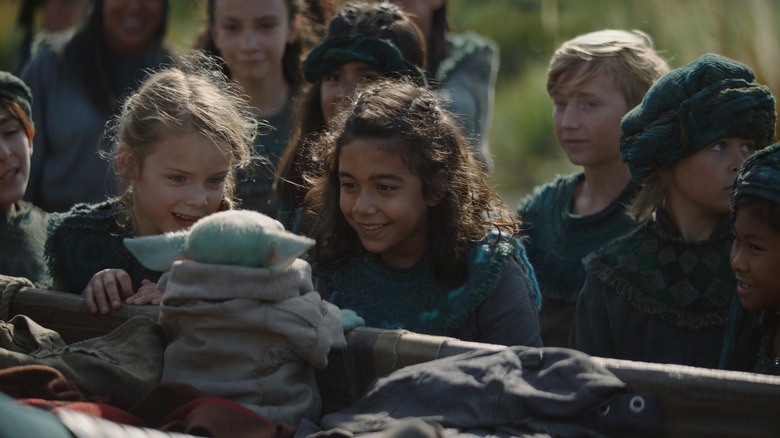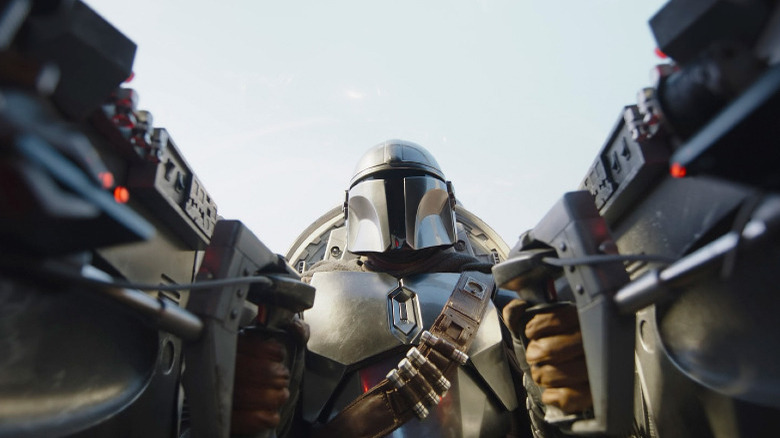Bryce Dallas Howard Knows What's Best About The Mandalorian
Joseph Campbell's hero's journey, aka the monomyth, has long formed the backbone of so much of "Star Wars." Where George Lucas' original "Star Wars" trilogy embraced the template, his prequel films sought to undermine it by questioning whether the very idea of a Chosen One could end up doing more harm than good. Years later, the Disney-backed sequel trilogy would take things a step further by centering on Rey, a protagonist whose lack of ties to any known "Star Wars" characters further subverted the concept one must be "destined" for greatness to bring about positive change in the world around them ... until the trilogy back-tracked on that, anyway.
Getting to the point: In contrast to the Skywalker Saga's examination of myths and how people mythologize heroes, the live-action "Star Wars" shows have found their groove by shifting their attention to a galaxy far, far away's working class and the unsung freedom fighters whose deeds make it possible for the Skywalkers to fly in and save the day (or, perhaps more often than not, the opposite). In the case of "The Mandalorian," the series moves away from the never-ending battle against tyranny and fascism to focus on the everyday people either trying to rebuild their lives in the aftermath of the Galactic Civil War or, in the case of Din Djarin, eke out a livelihood in the galactic gig economy as a bounty hunter and hired gun.
It's that same comparatively smaller scale, which "The Mandalorian" creator/showrunner Jon Favreau has admitted he prefers to the scope of big-budget tentpoles, that represents maybe the show's greatest strength — and it's Bryce Dallas Howard's willingness to embrace that scale as a director that makes her work on both the series and its spinoff, "The Book of Boba Fett," so rewarding.
The little things
For Bryce Dallas Howard, "Star Wars" is a true family affair. Her father, Ron Howard, not only directed "Solo: A Star Wars Story," but has long been friends with George Lucas, going back to their days working on "American Graffiti" together in the early 1970s. "My relationship to 'Star Wars' feels unique since I did grow up with George [Lucas]," Bryce Dallas Howard explained to BBC Radio 5 Live in 2020. "He had kids the same age as the kids in my family. We all really grew up together."
Nepo baby jokes aside, Bryce Dallas Howard has more than proven her artistic bona fides separate from her family name. The first episode she directed of "The Mandalorian," season 1's "Sanctuary," is a classic Kurosawan adventure that sees Din and Grogu team up with Rebel shock trooper turned mercenary Cara Dune to protect a small farming village from raiders on the planet Sorgan. But for all the action that transpires (more on that later), it's the smaller, intimate moments littered throughout the episode that stand out the most. The scenes of Grogu playing with the village's children remind us there's a whole galaxy of individuals just living their lives amidst the endless galactic warfare. When Din befriends a local widow named Omera and expresses his desire to give Grogu the happy childhood he deserves by leaving him there, only to realize that's not possible, it's a reminder that he himself is just some bloke in a helmet trying to do right by those he cares about.
Forget the "special appearances" by digitally de-aged beloved "Star Wars" movie actors or the attempts to make "The Mandalorian" and its spinoffs more narratively interconnected (à la the Marvel Cinematic Universe). This is the stuff that makes the show worthwhile.
Melding spectacle with everyday life
Far from lacking decent "Star Wars" spectacle, "Sanctuary" ends with a gripping showdown between the Sorgan villagers and their hired help, the raiders, and an AT-ST that turns the somewhat awkward "chicken walker" into a genuinely menacing, red-eyed, metallic monster. Bryce Dallas Howard would return to deliver another impressive chapter when she directed season 2's "The Heiress," an episode that climaxes with an exhilarating mid-flight heist. Like the AT-ST battle in "Sanctuary," Howard's steady direction results in an action sequence that's excitingly-paced yet easy to follow. it also compliments the episode's exceptional opening, in which Howard pays homage to her father's own space drama, "Apollo 13":
Nice catch!! 100% correct:) https://t.co/J1LSdvetYJ
— Bryce Dallas Howard (@BryceDHoward) November 14, 2020
As with "Sanctuary," though, "The Heiress" merges the various bells and whistles with quieter moments of everyday life we rarely have time for in the "Star Wars" movies. After the preceding episode, "The Passenger," made the dubious choice to turn Grogu snacking on Frog Lady's eggs into a dark running gag, "The Heiress" provides us the heartwarming sight of Frog Lady reuniting with her husband and tenderly introducing Din's tiny green son to their hatchlings. (Grogu himself nearly gets swallowed whole by a giant creature at one point, for those who felt he deserved a little payback.) Once again, the way Howard seamlessly blends domestic scenes with high-octane thrills makes all the difference in the world.
Even the Howard-directed "The Book of Boba Fett" episode, "Return of the Mandalorian" maintains that balance between top-notch action (Din's scuffle with a Klatooinian crime boss, the Siege of Mandalore history lesson) and simply hanging out with characters (Din catching a commercial flight to Tatooine and refurbishing an N-1 starfighter with Peli Motto). Again, these glimpses of civilian life aren't boring; they're the heart of the "Mandalorian" corner of the "Star Wars" franchise.
The future
Naturally, her efforts behind the camera on "The Mandalorian" have made Bryce Dallas Howard the fan-favorite pick to direct a future "Star Wars" film, and even some of her co-workers have expressed their desire to see her try her hand at helming a big-budget feature next. At the time of writing, however, Howard has her sights set on directing a reboot of the sci-fi movie "Flight of the Navigator." It's an appropriate choice for the budding filmmaker, too. After all, director Randal Kleiser's original 1986 feature is almost equal parts human drama and fantastical adventure and basically plays out as a kid-friendly take on "The Leftovers" for a significant chunk of its runtime. That is to say, it speaks to Howard's interest in combining emotion-driven storytelling with visual splendor.
Howard is also confirmed to be among the directors who worked on "The Mandalorian" season 3, which is comforting to know in light of the show's ongoing efforts to expand in scale and scope — turning its eye to the greater battle to reclaim Mandalore — while at the same time continuing to both set up and tie into other spinoff series. In doing so, though, there's a danger it will simultaneously abandon its greatest asset (its ability to highlight life among the not-so-legendary folk of a galaxy far, far away) and gradually become the type of stock hero's journey that's overly-trod territory for "Star Wars" at this point. Its creatives would do better to avoid going in that direction and look to Howard's example for what really makes "The Mandalorian" work.
"The Mandalorian" season 3 premieres March 1, 2023, on Disney+.



